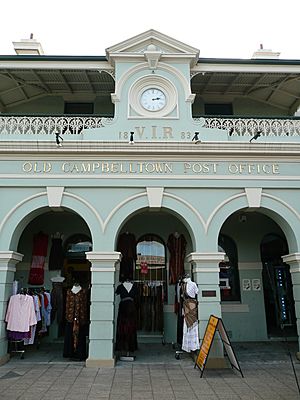Campbelltown Post Office facts for kids
Quick facts for kids Campbelltown Post Office (former) |
|
|---|---|

The former post office, pictured in 2008.
|
|
| Location | 261 Queen Street, Campbelltown, City of Campbelltown, New South Wales, Australia |
| Built | 1881 |
| Architect | James Barnet |
| Architectural style(s) | Victorian Italianate |
| Official name: Campbelltown Post Office (former); Campbelltown Post Office | |
| Type | State heritage (built) |
| Designated | 2 April 1999 |
| Reference no. | 265 |
| Type | Post Office |
| Category | Postal and Telecommunications |
| Lua error in Module:Location_map at line 420: attempt to index field 'wikibase' (a nil value). | |
The Campbelltown Post Office is a very old and important building in Campbelltown, New South Wales, Australia. It was built in 1881 and used to be a post office. Today, it has shops and offices inside.
This building was designed by a famous architect named James Barnet. It's known for its beautiful style, called Victorian Italianate. The building is so special that it's listed on the New South Wales State Heritage Register. This means it's protected because of its history and unique design.
Contents
History of Campbelltown
European settlers first came to the Campbelltown area in 1809. They were looking for new places to live because the Hawkesbury district often flooded. A road was built from Sydney to Liverpool starting in 1811. This road was later extended to Appin. It passed right through what became Campbelltown. This main road was first called High Street, but later it was renamed Queen Street.
The land where the old post office stands was given to Joseph Phelps in 1816. He had been farming there for several years. In 1817, the land was sold to William Bradbury.
How Campbelltown Got Its Name
Near Phelps's land, a special area was set aside for a new village. In December 1820, Governor Macquarie officially declared this area a town. He named it Campbelltown to honor his wife's family.
William Bradbury, who bought the land, was a convict sent to New South Wales in 1812. He later became a successful farmer and built an inn. Governor Macquarie visited Campbelltown in 1822 and even ate breakfast at Bradbury's inn. Macquarie noted that Bradbury was building a "very good two storey brick house" for travelers. He named Bradbury's farm "Bradbury Park."
Queen Street became the main street of Campbelltown. Even though one side of the street was outside the official town boundary, many shops and hotels were built there. When the railway arrived in 1858, it helped Queen Street become the town's main business area.
The Campbelltown Post Office Building
The land for the new post office was bought in 1880. The building was finished in 1881. It was designed by James Barnet, who also designed many other important public buildings in New South Wales.
Campbelltown was one of the first seven places in New South Wales to have a country postal depot. The first postmaster, John Scarr, was appointed in 1828. In 1883, a small clock designed by local architect A. R. Payten was added to the building.
Later, in 1959, part of the land was sold to the Australian government. This was likely for a telephone exchange.
After the post office was sold, the government made sure it would be protected. A special order was put in place in 1983 to preserve the building. This order was moved to the State Heritage Register in 1999, ensuring its long-term protection.
What the Building Looks Like
The former Post Office is a two-story building made of brick. It has a classic, old-fashioned look. The front of the building has three rounded arches at ground level, with a verandah (a covered porch) above.
A small panel in the middle of the building holds a clock. This clock was added in 1883. The building also has a smaller, single-story section next to it with a typical 19th-century verandah.
Changes Over Time
- 1881: The building was first constructed.
- 1883: A new verandah was added to the first floor, along with the clock.
- After 1915: A new verandah was added to the single-story part.
- 1987, 1994, 2006: Changes were approved to allow for a restaurant and cafe, including enclosing an outdoor eating area and building new structures.
Why It's a Heritage Site
The Campbelltown Post Office is very important for several reasons:
- Historical Significance: It was one of the first country postal depots in New South Wales. This shows its role in the early communication history of the region.
- Architectural Design: It was designed by James Barnet, a well-known architect. Its Victorian Italianate style makes it a beautiful and important building in Campbelltown.
- Streetscape Contribution: The building adds a lot to the look and feel of Queen Street in Campbelltown. It's a great example of a small country town post office from that time.
Because of these reasons, the Campbelltown Post Office was officially listed on the New South Wales State Heritage Register in 1999. This helps make sure it will be preserved for future generations to enjoy.

